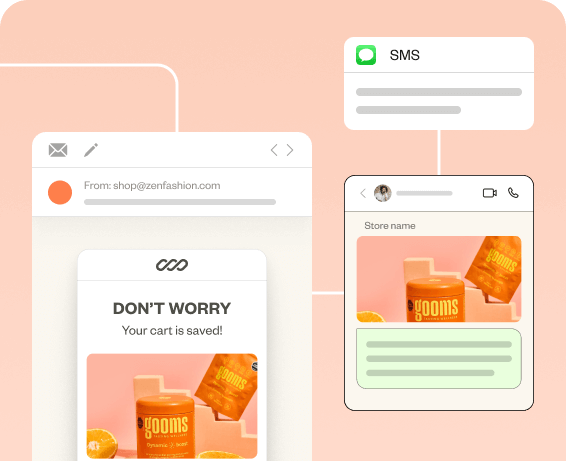Are you guilty of blasting the same emails to all customers without using email segmentation? It is an easy route, but it will not yield any conversions.
With 376.4 billion emails sent daily in 2025, standing out in crowded inboxes requires strategic email list segmentation. Consequently, you can engage customers and increase the conversion rates of your e-commerce store.
By segmenting email campaigns, you can achieve 50% more CTR and a 760% increase in revenue as opposed to the same email sent to all.
By the end of the blog, you will know
- Why segmentation is important in email marketing
- Most effective email marketing segmentation strategies
- Examples of well-worked segmentation of emails in 2025
- How to create email content for different customer segments
Let’s dive right in.
Discover multiple segmentation criteria in one place at Retainful and launch your tailored email campaigns in minutes.
What is Email Segmentation?
Email segmentation is a technique of dividing email lists based on customer characteristics like age, gender, location, purchase history, email engagement, and more.
Thus, with segmentation in email marketing, you can send personalized email marketing campaigns to match the unique characteristics of every customer and resonate with the customers’ needs and interests.
Audience segmentation for email campaigns is the most effective email marketing strategy to retain customers and thus drive repeat sales. In fact, 78% of marketers consider it their top strategy.
What is the difference between email segmentation and personalization?
- Email Segmentation involves dividing your email list into groups based on criteria like age, location, or purchase history.
- Personalization means tailoring the email content to match those criteria, making each email feel unique to the recipient.
Powerful Benefits of Email Segmentation (Backed by Data)
In Hubspot Research 2021, email segmentation (78%) and personalization (72%) were identified as the most effective strategies in email marketing.
Furthermore, 25% of revenue generation can be traced to segmented email lists.
The benefits of email segmentation are:
- High personalization and engagement
- High open and click-through rates
- High conversion rates
- Low unsubscribe rates
- High email deliverability
Let’s see in detail the benefits of doing audience segmentation for email campaigns.
Boost Personalization & Engagement
Email personalization goes hand in hand with segmentation. The more personalized your emails are, the more engaged your customers will be.
The main reason why segmentation is important in retention email marketing is that you can send personalized email campaigns that convert more than generic ones.
Ideally, 74% customers ignore email content that isn’t relevant to them. Hence, segmenting customers based on their unique characteristics, like purchase history, interests, and demographics, makes your email content resonate more.
Increase Open & Click-Through Rates
Segmented email campaigns had 100.95% clicks more compared to non-segmented emails globally, according to Mailchimp.
B2B segmented campaigns specifically see 17% higher open rates and 30% higher click-through rates.
The benefit of email segmentation is that segmented email campaigns are more relevant to the audience, and they tend to have higher open and click-through rates compared to non-segmented campaigns.
Drive 3X Conversion Rates
According to Campaign Monitor, segmented email campaigns result in a 760% increase in revenue.
Segmented email campaigns can lead to higher conversion rates as they target subscribers with content and offers that are most relevant to them.
For example, sending a promotion for baby products to recent parents rather than the entire email list makes a conversion more likely.
The sheer number of conversions you get is the reason why email segmentation is more important than any other email marketing strategy out there.
Reduce Unsubscribe Rates
When marketing emails are consistently relevant and engaging, subscribers are less likely to feel overwhelmed or annoyed by your communications, leading to lower unsubscribe rates.
Stats reveal that by segmenting your email campaigns for personalization, you can reduce unsubscribe rates by 9.4%
Maximize Email Deliverability & Inbox Placement
By sending relevant emails through email segmentation, it is very unlikely that you will send unengaging and spammy content.
It decreases the chance of your emails landing in the spam folder and increases overall email deliverability.
Now that we know why segmentation matters in email marketing let’s move on to learning how you can segment email lists based on various criteria.
How to Segment Email Lists: 5 Essential Methods
You can segment email lists based on the various unique characteristics of your customers.
Personalized emails are not only about mentioning the customer’s name in the email; they go much beyond that.
Let’s look at how to segment your email list with the help of customer data and send more tailored content.
5 ways to segment email lists are:
- Demographic Segmentation Strategies
- Behavioral Segmentation Techniques
- Preference-Based Segmentation Tactics
- Customer Lifecycle Stage Segmentation
- Purchase History-Based Segmentation
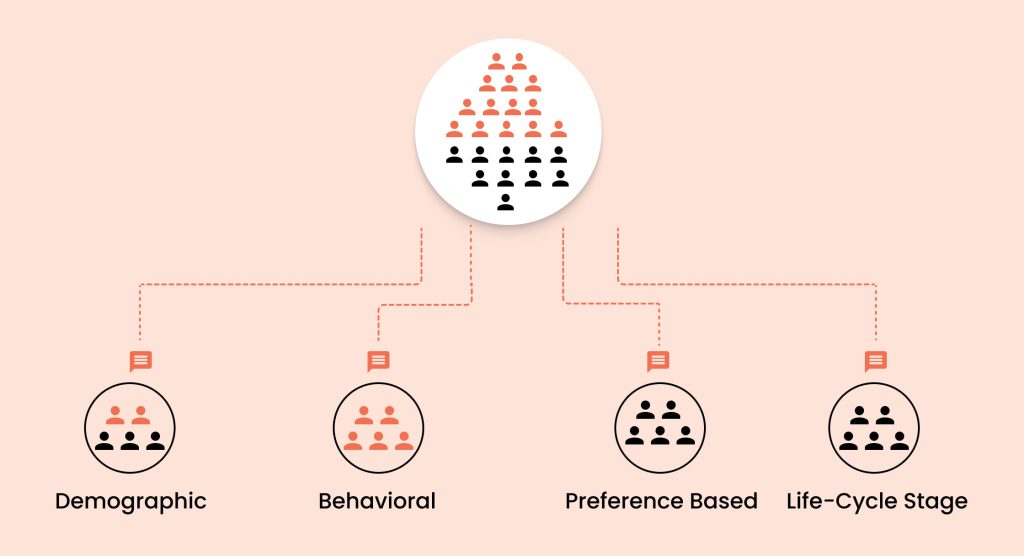
1. Demographic segmentation
Criteria: Age, gender, location, income, education level, occupation, etc.
Demographic segmentation is one of the most straightforward ways to categorize customers, as these factors significantly influence buying behavior and product preferences.
For example, marketing strategies that appeal to millennials may not resonate with baby boomers.
2. Behavioral segmentation
Criteria: Purchase history, website activity, email engagement, shopping cart abandonment, etc.
Customer behavioral segmentation offers insights into customer interactions with your brand. Thus, understanding a customer’s past purchases can predict future buying behavior, enabling you to recommend relevant products.
For example, customers with high email engagement could receive exclusive deals to encourage conversion.
3. Preference-based segmentation
Criteria: Product interest, content preferences, etc.
This type of email marketing segmentation focuses on the specific interests and preferences of your customers, thus ensuring that the content and products they receive are aligned with what they value most.
4. Lifecycle stage segmentation
Criteria: New customers, active customers, inactive customers, loyal customers, etc.
Customers at different stages of their relationship with your brand have different needs and expectations. Hence, lifecycle-based email list segmentation allows businesses to nurture these relationships appropriately, from welcoming new customers to re-engaging inactive ones and rewarding loyal customers.
5. Purchase history-based segmentation
Purchase history has a goldmine of information about your customer’s purchasing behavior – what type of products they have purchased before, the frequency and recency of purchases, and the total purchase value.
Here are the criteria to consider in this type of email segmentation when sending personalized emails.
- Frequency of purchases
- Total purchase value
- Product categories
- Purchase history trends
12 Best Email Segmentation Strategies (Proven to Increase 46% Revenue)
The best email segmentation strategies are:
- Geographic & Location-Specific Segmentation
- RFM Segment Analysis (Recency, Frequency, Monetary Value)
- Advanced Purchase History Segmentation
- Email Engagement Scoring & Optimization
- New Subscriber Welcome Sequences
- Abandoned Cart Recovery Campaigns
- Product Viewing Behavior Tracking
- Sales Funnel Stage Optimization
- Personal Interest & Preference Targeting
- Discount Code Usage Patterns
- Predicted Customer Lifetime Value (CLV)
- Content Interest & Engagement Analytics
Let’s see how you can implement these email segmentation strategies in your email campaigns.
1. Geographic & Location-Specific Segmentation
Local-specific or geographic segmentation is one of the most basic email segmentation strategies.
You can predict customer preferences with their demographic data. If you are running a clothing store, sending emails about monsoon season offers will work for Asian customers but not for Americans. Similarly, you wouldn’t want to send a recommendation email for a gaming product to a 40-year-old.
Here is an email segmentation example by Nanit.
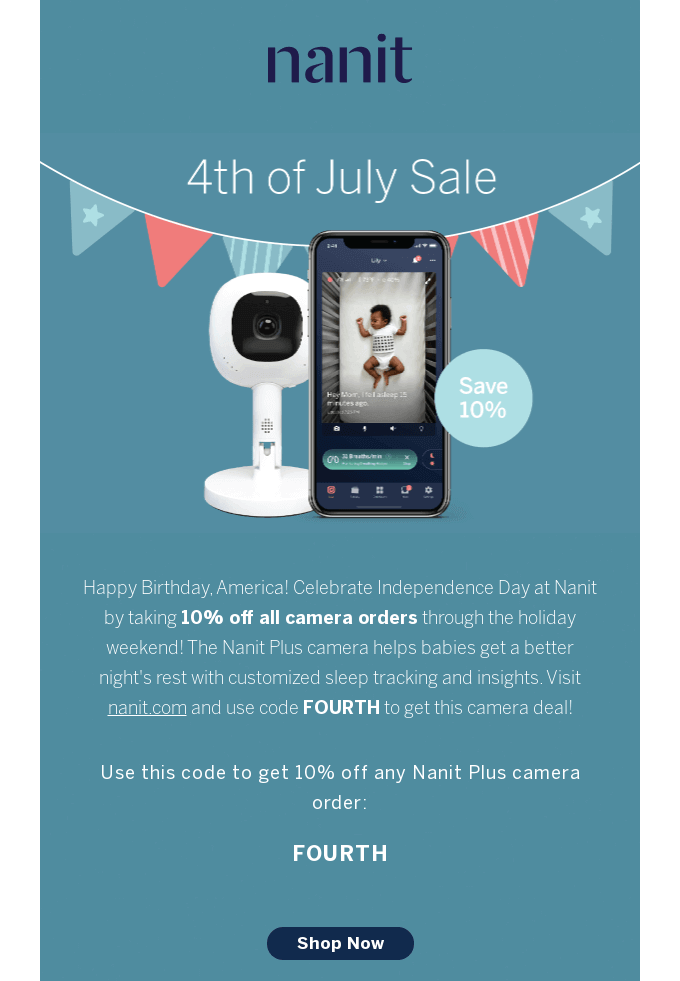
If you have customers worldwide, it would make sense to send a July 4th email only to North Americans.
2. RFM Segment Analysis (Recency, Frequency, Monetary Value)
RFM (Recency, Frequency, Monetary value) technique is used to identify a business’s best customers.
- Recency(R) – How recently a customer made a purchase.
- Frequency (F) – How often a customer purchases within a given period.
- Monetary value (M) – How much money a customer has spent during a given time.
These values tell who your high-value and low-value customers are.
Here is an example of how to segment customers based on RFM analysis:

How to create email content for high-value customer segments:
Include rewards like exclusive offers, VIP access to product launches, loyalty program invitations, personalized thank-you notes, and more.
How to create email content for low-value customer segments:
Do upselling and cross-selling to encourage repeat purchases, include limited-time offers, request feedback, and more.
Here is how Sunglass Hut implemented this email segmentation idea.
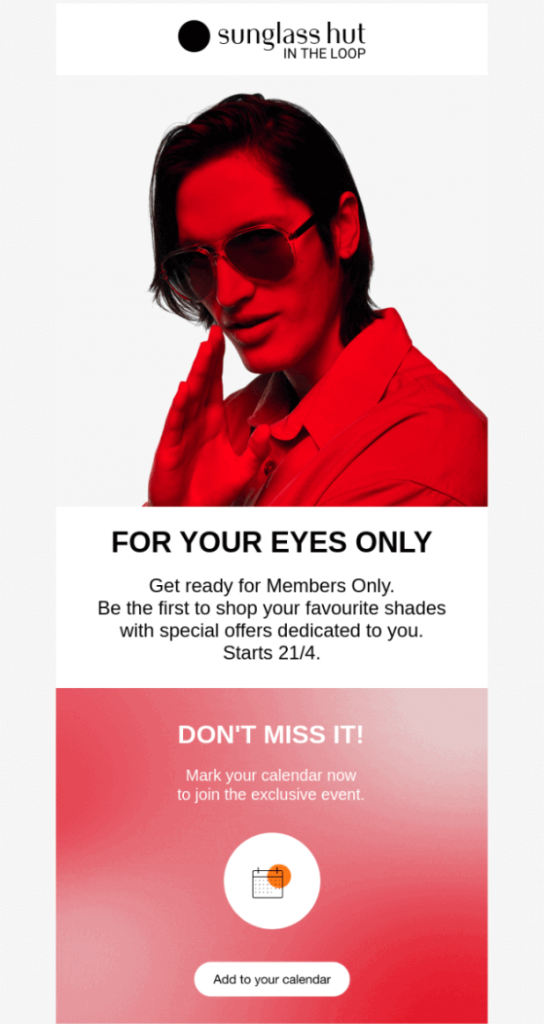
3. Advanced Purchase History SegmentationHistory
Purchase history has a goldmine of information about your customer’s purchasing behavior – what type of products they have purchased before, the frequency and recency of purchases, and the total purchase value.
Here is how you can use purchase history as an email marketing segmentation strategy and following that create email content for different customer segments in purchase history-based segmentation.
- Frequency of purchases – Send exclusive offers for frequent buyers and limited-time offers and product recommendations to occasional buyers. If they haven’t purchased for more than 90 days, send them a win-back email.
- Total purchase value – Offer high-value customers exclusive offers, send cross-sell and upsell emails, and additionally invite them for a loyalty program.
- Product categories – Send cross-sell and up-sell emails, re-stock reminders, and product usage guides.
- Purchase history trends – Send emails featuring products related to the current season or upcoming holidays.
Here is how Adidas this email segmentation idea.
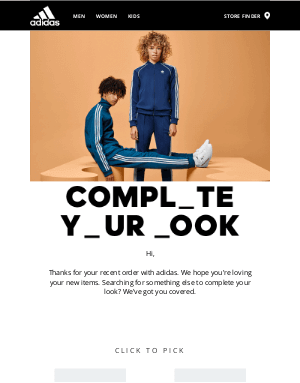
You can implement email segmentation ideas like this by segmenting email lists by product category and recommending a complementary product in the email.
4. Email Engagement Scoring & OptimizationEngagement
Email engagement indicators will tell you what to send and how frequently you should send emails in the future.
To implement this email segmentation idea, create email segments for highly engaged subscribers (frequent openers and clickers), moderately engaged subscribers, and less engaged subscribers.
Here is how to create email content for different customer segments in engagement-based segmentation:
- Less engaged customers – Send re-engagement emails with incentives or fewer emails to avoid unsubscribes.
- Highly engaged customers – Send exclusive offers and more frequent emails.
5. New Subscriber Welcome Sequences
Personalizing welcome emails to address specific interests or demographics makes the content more relevant and engaging.
You can segment new customers based on the source of sign-up, demographics, preferences, and interests.
Track where subscribers signed up, such as your website, blog, social media, or landing pages. Then, use this to understand their initial interest.
Here is how Glossier implemented this email segmentation idea in their welcome email.
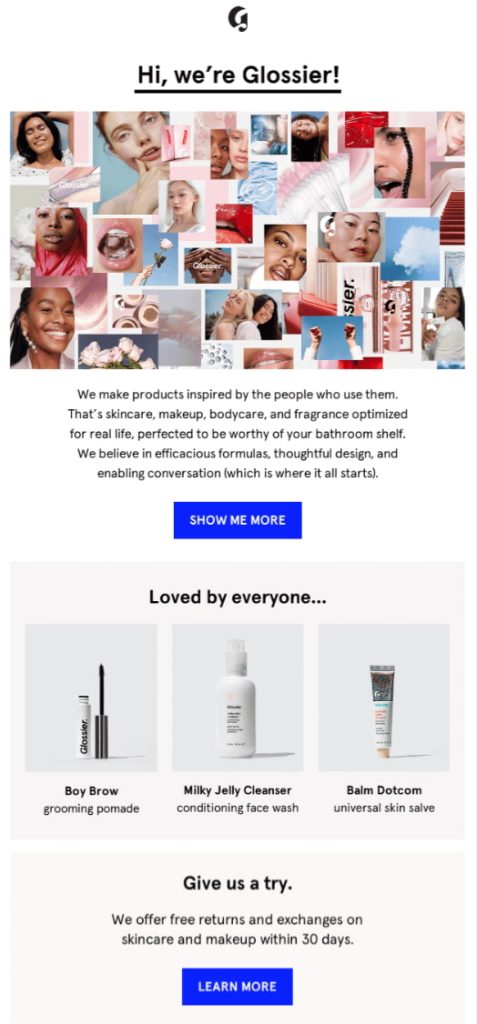
6. Abandoned Cart Recovery Campaigns
Segmentation based on abandoned cart history is one of the ecommerce email segmentation strategies that you shouldn’t turn your back on.
You wouldn’t want all of your abandoned cart emails to look the same; say the same “Your cart is waiting for you” tagline. Thus, segment the customers who abandoned carts based on the items in the cart, average cart value, and frequency of abandonment.
With dynamic content blocks in the email, you can include abandoned items directly in the email. Moreover, segmenting email lists by average order value allows you to give them special treatment, like sending exclusive offers.
Here is an ecommerce email segmentation example by Fabletics Men.
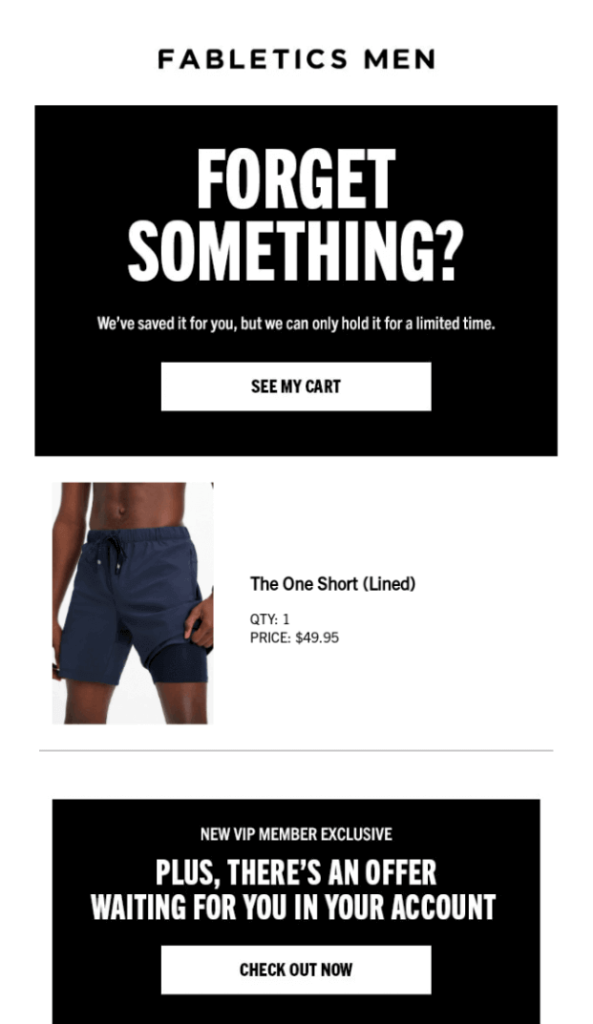
See how they included a VIP Member Exclusive offer. This ecommerce email example can’t be crafted without segmenting the abandoned cart customers by VIPs or non-VIPs.
7. Product Viewing Behavior Tracking
In ecommerce email segmentation, you can also collect data from customers’ website activity and segment them based on that. Products they have viewed are a great clue into what they are interested in, and all they need is a little nudge to purchase.
You can also provide exclusive discounts for products they viewed. This creates a sense of urgency and encourages conversion.
You can use tools like Google Analytics and Hotjar to track viewed products and following that integrate these tools with your email segmentation tool.
Here is how Rael implements this email marketing segmentation strategy.
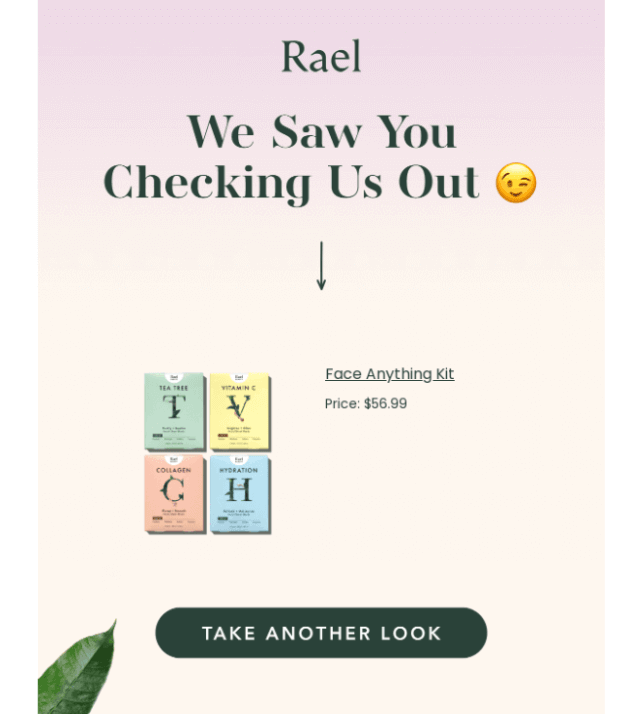
8. Sales Funnel Stage Optimization
The ultimate goal of ecommerce email segmentation is to send relevant content to the customers. The stage of the funnel clearly tells you about customers’ varying needs and pain points, allowing you to address them in your emails.
Here is how to create content for different customer segments based on the life-cycle stage:
- Awareness stage – Customers in this stage have recently discovered your brand or product. Send newsletters with educational content, blog posts, and welcome emails to nurture their interest.
- Consideration stage – Customers here are actively considering your products or services. Send product recommendations, comparison guides, and customer reviews to help them make informed decisions.
- Decision stage – These subscribers are close to making a purchase decision. Send them personalized offers, discounts, or product recommendations to encourage conversion.
- Post-purchase stage – Subscribers who have made a purchase. Send next-order coupons, loyalty rewards, and upsell or cross-sell emails to encourage repeat business.
- Referral stage – These customers are satisfied and can become brand advocates. Send referral incentives, request reviews, or invite them to join your loyalty program.
- Abandoned Cart stage – Send cart recovery emails with personalized product recommendations and incentives.
- Inactive/Win-back stage – Segment based on the length of inactivity. Send win-back emails, special offers, or re-engagement campaigns to rekindle their interest.
There are quite a lot of ways you can gather data to determine which stage the customer is in. For example, someone who fills out a sign-up form is likely in the consideration stage, while a customer who completes a purchase has reached the post-purchase stage.
Email segmentation tools allow you to segment your email list based on product page visits, email open rates, or time spent on your site.
Here is how Fulton uses this ecommerce email segmentation strategy.
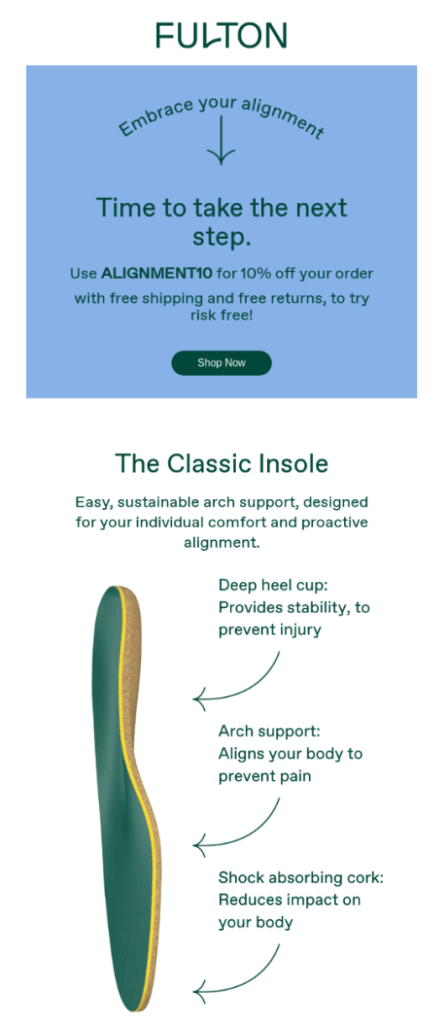
This email segmentation example would typically be sent to someone in the decision stage. They have viewed the product and just need a little push to click “Buy.”
Send automated personalized emails that engage more with Retainful’s easy-to-use email segmentation and automation feature.
9. Personal Interest & Preference Targeting
Other than the above email list segmentation strategies, a simple survey or making the customers choose their interests in the site would give a peek into their persona.
If they choose sportswear instead of formal wear, you can recommend sports products in your emails.
10. Discount Code Usage Patterns
Unique coupon codes you have offered will give you data for customer segmentation if you track their usage. You can unlock it by tracking their usage. Some criteria you can consider are high-spenders, seasonal shoppers, and first-time buyers.
If you offer discounts on specific product categories like “20% off Apparel”, segment customers who have redeemed codes for those categories. Send them relevant product recommendations and similar offers.
11. Predicted Customer Lifetime Value (CLV)
You can’t miss out on those long-term customers who have stuck with you for so long. Identify them by calculating average purchase value and average purchase frequency and longevity. Those who have scored high on these categories are your high lifetime value customers.
Create email content for the customer segment with high lifetime value with appreciation for their loyalty and repeat business and offer exclusive perks, such as early access to sales or VIP events.
This is how Moment implements this email segmentation strategy.
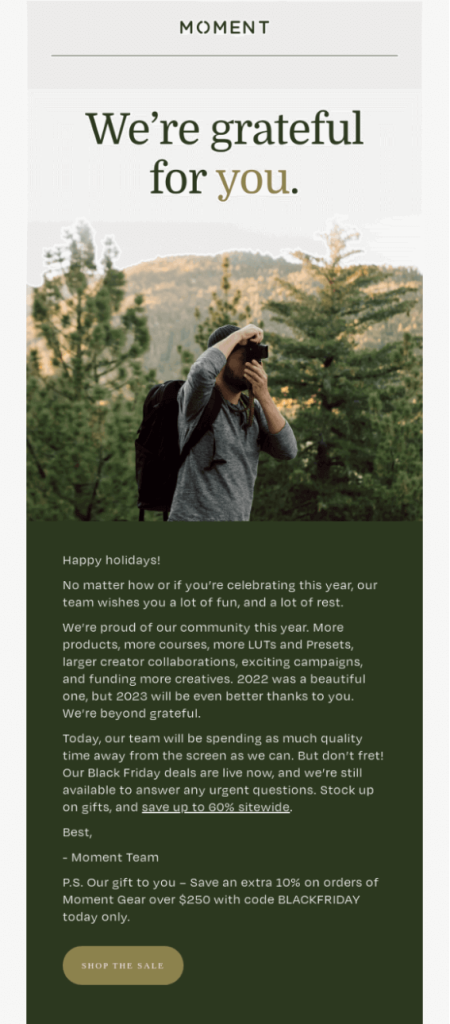
This is an email segmentation example of how you can be grateful for your high lifetime value customers and give them an exclusive offer.
12. Content Interest & Engagement Analytics
In this email segmentation strategy, you segment your customers based on what content they like – videos, images, blogs, or instructional guides.
Keep an eye on what content they engage with (e.g., blog posts, videos, articles) on your site and track which emails they open and which links they click.
There you have it. 12 best email marketing segmentation strategies to create targeted email campaigns.
Now, let’s move on to learn about some of the best practices you should follow while creating this email list segmentation.
5 Essential Email Segmentation Best Practices
Every segment you create indicates differences in the preferences, needs, and behaviors of customers.
The goal of email segmentation in email marketing is to send emails that align with those unique differences and ultimately engage the customers.
To meet this goal, you have to follow some of the email list segmentation best practices below:
Data Quality & Accuracy Management
To do targeted email marketing, ensure that your customer data is accurate and up to date. Inaccurate data can lead to incorrect segmentation and ineffective campaigns.
Strategic Segmentation Criteria Selection
Define clear criteria for segmenting email lists. If you are just getting started with email segmentation, start with just 2-3 segments that will make the most impact.
Advanced Email Personalization Techniques
Craft highly personalized email content tailored to each customer segment. This includes using the recipient’s name, referencing past interactions, and recommending products or content based on their history.
Audience segmentation for email campaigns will be incomplete without personalizing the emails.
Testing, Tracking & Performance Optimization
Continuously test your email segmentation strategy and email content to identify what works best. A/B testing can help refine your targeted email campaigns over time. And keep an eye on unsubscribes.
Email Marketing Automation Integration
As an email segmentation best practice, use marketing automation tools to streamline your email list segmentation efforts.
Email automation can ensure that emails are sent to the right segments at the right times, improving efficiency and accuracy.
Step-by-Step Email Marketing Segmentation Implementation Guide
On the face of it, email list segmentation can be quite overwhelming; let’s simplify it further by a step-by-step guide.
Step 1: Choose the Right Email Segmentation Tool
A good email marketing platform takes the load off you and allows you to do email list segmentation without a 3-page manual. Choose one and integrate it with your e-commerce store.
Choose an email segmentation tool that has features like:
- Pre-built segmentation templates
- Advanced email segmentation capabilities
- Email automation
Step 2: Define Your Segmentation Criteria & Goals
Define your goals for specific email marketing segmentation criteria – is it for customer retention, abandoned cart recovery, or promotions? Then, select a criteria that align with the goal.
Step 3: Build & Organize Your Segmented Email List
Pick your chosen criteria in the email automation platform.
In Retainful, it can be done in a few simple steps. You can choose pre-defined email segmentation templates like abandoned cart customers, inactive customers, VIP customers, new customers, and active email subscribers, or you can create your own rules from scratch.
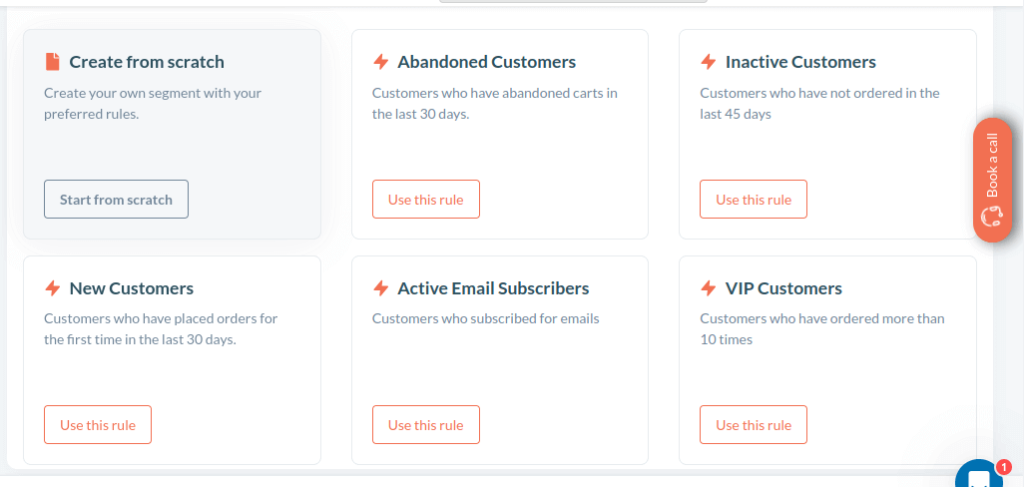
Here is an example of two segmentation criteria – abandoned carts and purchase history.
You can segment the abandoned cart customers in multiple ways in Retainful – such as abandoned date, abandoned product name, total number of abandoned carts, and cart value, among others.
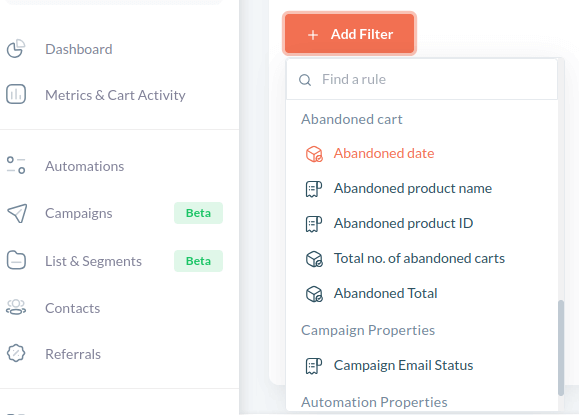
In the case of purchase history, you can segment customers by number of orders, order total, product name, and product ID, among others.
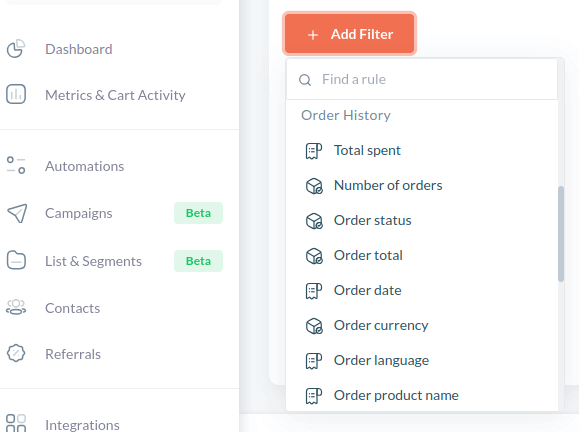
Now, you can use these segments effortlessly while creating your targeted email campaigns.
Step 4: Create an Email for Each Segment
After segmenting email lists, it is time to craft relevant email content based on the customer’s interests and needs.
Here is how to create email content for different customer segments:
- High-value/ VIP customer segment: Suggest high-end products and give early access to sales.
- New customers segment: First purchase offer and product tips.
- Inactive customers: Highlight what’s new and give a comeback offer
- Abandoned cart customers: Objection handling emails and free shipping/ offer emails
Step 5: Monitor KPIs & Optimize Performance
Measure key email marketing metrics to know how your segmented email campaigns are performing.
Experience the dual power of email segmentation and automation in Retainful and send targeted email campaigns.
Wrapping up!!
The ultimate goal of email segmentation is to make the customers feel that your emails resonate with their current situation so that they are more likely to take the desired action, whether signing up, making a purchase, or referring others.
Going forward, AI will overtake the segmentation of emails. It is already reported that 51% AI-segmented emails are better than ones done manually.
Hence, the time is right to implement the best email list segmentation strategies from this blog and follow the email marketing segmentation best practices to see results for your store.
Learn more about how to do better email marketing:
- 8 Email Capture Best Practices to Grow Email List
- Difference Between Email Segmentation and Personalization
- 9 Post-purchase Email Examples That Retain Customers
Frequently Asked Questions
An email list is a collection of all of your email contacts grouped together.
A segment is a subset of your email list created based on specific criteria or conditions.
You can segment email lists based on demographics, purchase history, email engagement, and behavioral data, stage of the email marketing funnel and more.
A segmented email campaign refers to emails that are sent to a group of customers segmented based on demographics, purchase history, email engagement, and more.
By segmenting your customers, you can see a huge increase in the conversion rate and engagement rate of your emails.
An example of segmentation in email marketing is dividing an email list into segments based on purchase history. Thus, you can send exclusive offers to frequent shoppers.
The benefits of email segmentation are likelihood of meeting customer needs and driving desired actions. As a result, you get higher open and click-through rates, engagement, reduced unsubscribe rates, and ultimately increase revenue.
A good email segmentation tool should allow you to segment your customers based on numerous criteria with ease. Here are some of the tools: Retainful, Omnisend, Constant Contact, and Campaign Monitor among others.
To do audience segmentation for email campaigns segment your audience based on customer data like age, gender, location, purchase history, email engagement, and more. After segmenting, create email content for each of the segments addressing their unique concerns and interests.
